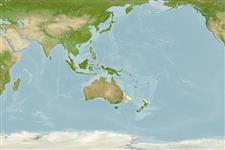Environment: milieu / climate zone / depth range / distribution range
Ecologia
marinhas batidemersal. Deep-water
Indo-West Pacific: Australia.
Tamanho / Peso / Idade
Maturity: Lm ? range ? - ? cm
Descrição breve
Chaves de identificação | Morfologia | Morfometria
Raios dorsais moles (total) : 111 - 119; Raios anais moles: 98 - 104; Vértebras: 59 - 65. With a 1-2-2 pattern of interdigitation of proximal dorsal pterygiophores and interneural spines (ID); 9 abdominal vertebrae; 110-125 scales in a longitudinal series; whitish or yellowish blind side which is distinctly lighter than the ocular surface (Ref. 35979).
Life cycle and mating behavior
Maturidade | Reprodução | Desova | Ovos | Fecundidade | Larvas
Munroe, T.A. and K. Amaoka, 1998. Symphurus hondoensis Hubbs, 1915, a valid species of Western Pacific tonguefish (Pleuronectiformes: Cynoglossidae). Ichthyol. Res. 45(4):385-391. (Ref. 35979)
Categoria na Lista Vermelha da IUCN (Ref. 130435: Version 2024-2)
Ameaça para o homem
Harmless
Utilização humana
Ferramentas
Relatórios especiais
Descarregue XML
Fontes da internet
Estimates based on models
Preferred temperature (Ref.
123201): 2.6 - 6.8, mean 4.4 °C (based on 42 cells).
Phylogenetic diversity index (Ref.
82804): PD
50 = 0.5000 [Uniqueness, from 0.5 = low to 2.0 = high].
Bayesian length-weight: a=0.01072 (0.00507 - 0.02267), b=3.11 (2.92 - 3.30), in cm total length, based on LWR estimates for this (Sub)family-body shape (Ref.
93245).
Nível Trófico (Ref.
69278): 3.3 ±0.4 se; based on size and trophs of closest relatives
Resiliência (Ref.
120179): Elevada, tempo mínimo de duplicação da população menor que 15 meses (Preliminary K or Fecundity.).
Fishing Vulnerability (Ref.
59153): Low vulnerability (10 of 100).
